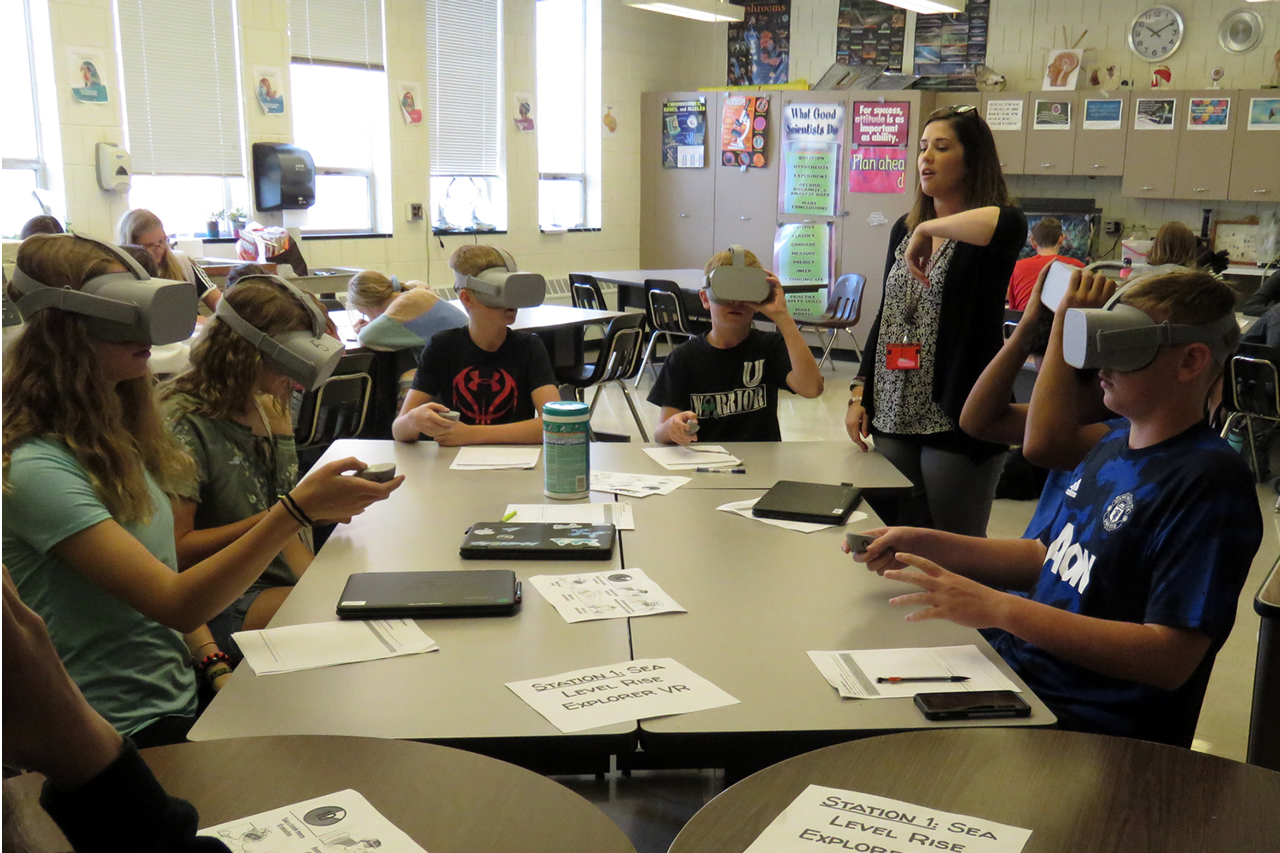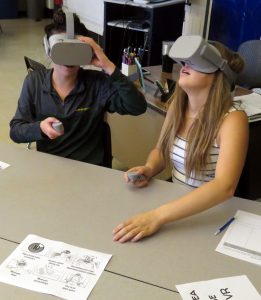Science teacher Emily Telford knew that it would be a lot more interesting for her freshman to examine sea level rise while flying over waterways in a blimp, so that’s exactly what she had them do- virtually, that is, through Oculus Go headsets that her classroom has access to.
“I needed them to grasp the concept of just how much water levels change over time due to climate change,” said Telford. “In the past, I would have had them look at pictures or watch a YouTube video, but it doesn’t always register with them as forcefully as I’d like.”
Telford, along with faculty-associate Megan Fleri-Somers, has been leading an effort at U-High to figure out effective—and practical—ways that virtual learning can be used to improve student learning.
On this day, Telford is using an app called “Sea Level Rise Explore VR” which centers around an area of Fleming Park, Maryland. Much of the area around their local parks has become submerged by nearby waterways flowing in from the ocean. Once in the Oculus Go, students are taken on a narrated tour that begins with them looking at side and aerial views of a model of the area, and then, takes them on a blimp-ride above the park. In the app, students can use a slider to go back in time up to six years, enabling them to see the diminishing land space.
“I’m finding it works well as part of the 5E model that we’re using in our freshman program,” said Telford. “When I can use virtual reality to take a student to an actual place where they can see the impact of rising water due to climate change, that’s helps build engagement, which is the first “E”.”
The experience elicited a wide range of comments from students, including “whoa, this is cool”, “this is scary”, and “can I continue exploring?” Each student was given approximately 15 minutes to complete the virtual activity. Afterwards, they listed their observations, what they could infer from what they saw, and any questions they had from the virtual experience.
Telford has used virtual devices like Google Cardboard in the past, but when she saw the power of the Oculus Go she realized it created an opportunity for more in-depth experiences. Last January, she began meeting with Fleri-Somers to develop authentic ways to integrate VR in her classroom.
“I see it as an opportunity to foster empathy,” said Fleri-Somers, who’s looking at using virtual apps like “Traveling while Black” during her Civil Rights unit. “Students can experience events that they couldn’t otherwise experience in the classroom.”
“I see it as an opportunity to foster empathy- students can experience events that they couldn’t otherwise experience in the classroom.,” said Fleri-Somers.”
For both teachers, figuring out the logistics was- and is- a big part of successful implementation.
“It starts with having an idea for a lesson and investigating whether there’s a VR experience that would help students to better see or visualize an anchoring phenomenon,” said Telford. To help with that, she’s enlisted the aid of Library Media Specialist Amy Brokaw to figure out the logistics that need to be put in place, including whether anything new needs to be installed on the Oculus Go headsets, making sure they are charged, identifying the starting point for students and so forth. Brokaw joins the class during these activities to manage the virtual learning group.
“Having another educator involved to help manage that station, help kids troubleshoot, and answer their questions makes it very doable,” said Telford.
Telford has found other experiences that she has taken her students through as well. In her biology classes, she has had students view the world through the eyes of everything from a dragonfly to an owl. Fleri-Somers coordinated the Oculus Go’s for her during those lessons, and said she was impressed by the level of questions it was evoking from students.
“Kids kept asking ‘why is this happening’”, said Fleri-Somers. “They were genuinely curious.”
Meanwhile, both teachers are looking ahead to other planned virtual trips. Telford plans to have her Zoology students ‘travel’ to the coral reefs to see the effects coral-bleaching. In Anatomy class, she plans to have her students travel into the bloodstream where they can view how the body protects against pathogens. Fleri-Somers plans to have her U.S. Studies students visit the Anne Frank house as part of a Holocaust unit.
“I’m very excited about the future of VR in education,” said Telford. “I feel very lucky to be working in a lab school where I am encouraged to share my passion for educational technology with teacher-candidates, and where I’m given tools to research how VR can transform and enhance the learning experience.”


